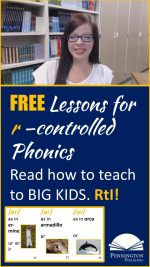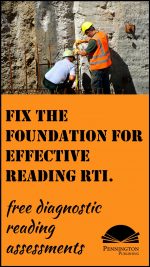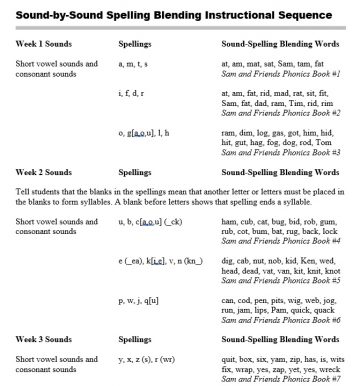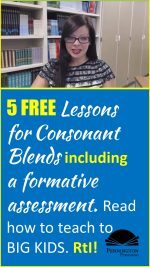Should We Teach High Frequency Words?
As a reading specialist, I am also asked if we should teach high frequency words. I do agree with Dr. Tim Shanahan that learning a small bank of these words in kinder makes sense; however, beyond that, my take is that teaching older students (or more likely practicing and testing) long lists of high frequency reading words or using them in spelling instruction is counterproductive.
Memorizing lists of 200, 300, 400, 500 high frequency words treats language acquisition as a process of rote learning and viewing each and every word in isolation. This approach falsely teaches students that every reading and spelling word is an exception. The old Dick and Jane look-say method of reading and spelling instruction has been properly relegated to the instructional dumpster; however, high frequency instruction remains a hold-out to some degree. Why is this so? My take is because “Let’s teach the words students will read and write most often” seems intuitively correct. However, intuition is not science and should not guide our instructional decisions.
But What about High Frequency Words with Non-Phonetic Sound-Spellings?
Included within the lists of high frequency words are a subset of words with non-phonetic parts. I call the 108 (plus or minus depending on list and how one counts inflections) words with non-phonetic spellings, Heart Words; others refer to them as “rule-breakers,” irregular words,” “outlaw words,” “tricky words,” “memory words,” and others. Of the 100 highest frequency English words, many are non-phonetic because they derive from Old English.
Most reading specialists would agree that the Heart Words should be introduced concurrently with explicit, systematic phonics instruction. For example, I introduce the 108 highest frequency Heart Words two at a time in my 54 decodable Sam & Friends Guided Reading Phonics Books.
Many of these Heart Words may have unusual spelling patterns, but as students acquire more reading and spelling knowledge, they find that some words initially learned as Heart Words have the same unusual spelling pattern as others. When we teach these “rule breakers,” we need to show students how many of them belong to the same patterns. For example, the Heart Word, one, has similar patterns as the Dolch words: some (30), come (64), and done (180). The more we show the patterns of the English orthographic system, the easier it is for beginning readers to map these words to their orthographic memories. These words can become immediately recognizable in reading and far easier to spell once they reach the level of sight word automaticity.
Researchers Linda Farrell and Michael Hunter completed a study on the Dolch 220 list of high frequency words. Of the 220 words, 82 were identified as Heart Words (37%), and 45 of the words can be studied in similar pattern words. https://www.readingrockets.org/article/new-model-teaching-high-frequency-words
Reading specialists do disagree about which words would be classified as Heart Words. Although the reading research is clear that memorizing whole words, such as in the outdated “Look and Say” approach, is inefficient, some reading teachers stress that teaching students to remember whole words is important as a part of orthographic mapping. In orthographic mapping, students are wiring the brain to remember all of the sound-spellings of a word in order as a unified whole. These become true “sight words,” because they are recognized automatically by sight, and not any longer by sounding each phoneme (speech sound) out. For example, students might be taught that the Heart Word the is “not all irregular.” In other words, the “th” /th/ follows the rules; it’s only the “e” that does not. It is “the part to learn by heart.” Plus, when used before words beginning with vowels, the the is perfectly regular because the “e” makes the long /e/ sound for example, thē army and thē elephants in most regional dialects.
Check out my article on How to Teach Heart Words for seven activities to do so.
A sound box is often used to help students map heart Words, because they require more instruction than phonetically regular words.

Sound Boxes
*Sight words assessments (also referred to as word recognition, e.g. The Slosson Oral Reading Test) shouldn’t be confused with instruction.
*****

The Science of Reading Intervention Program
The Science of Reading Intervention Program: Word Recognition includes explicit, scripted instruction and practice with the 5 Daily Google Slide Activities every reading intervention student needs: 1. Phonemic Awareness and Morphology 2. Blending, Segmenting, and Spelling 3. Sounds and Spellings (including handwriting) 4. Heart Words Practice 5. Sam and Friends Phonics Books (decodables). Plus, digital and printable sound wall cards and speech articulation songs. Print versions are available for all activities. First Half of the Year Program (55 minutes-per-day, 18 weeks)
The Science of Reading Intervention Program: Language Comprehension resources are designed for students who have completed the word recognition program or have demonstrated basic mastery of the alphabetic code and can read with some degree of fluency. The program features the 5 Weekly Language Comprehension Activities: 1. Background Knowledge Mentor Texts 2. Academic Language, Greek and Latin Morphology, Figures of Speech, Connotations, Multiple Meaning Words 3. Syntax in Reading 4. Reading Comprehension Strategies 5. Literacy Knowledge (Narrative and Expository). Second Half of the Year Program (30 minutes-per-day, 18 weeks)
The Science of Reading Intervention Program: Assessment-based Instruction provides diagnostically-based “second chance” instructional resources. The program includes 13 comprehensive assessments and matching instructional resources to fill in the yet-to-be-mastered gaps in phonemic awareness, alphabetic awareness, phonics, fluency (with YouTube modeled readings), Heart Words and Phonics Games, spelling patterns, grammar, usage, and mechanics, syllabication and morphology, executive function shills. Second Half of the Year Program (25 minutes-per-day, 18 weeks)
The Science of Reading Intervention Program BUNDLE includes all 3 program components for the comprehensive, state-of-the-art (and science) grades 4-adult full-year program. Scripted, easy-to-teach, no prep, no need for time-consuming (albeit valuable) LETRS training or O-G certification… Learn as you teach and get results NOW for your students. Print to speech with plenty of speech to print instructional components.














